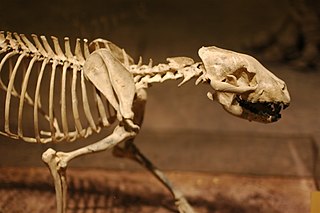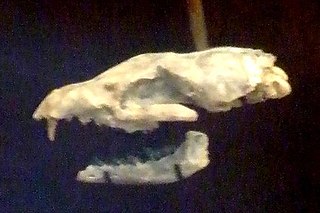
Borophagus is an extinct genus of the subfamily Borophaginae, a group of canids endemic to North America from the Middle Miocene epoch through the Late Pliocene epoch 12—2 Mya.

The extinct Borophaginae form one of three subfamilies found within the canid family. The other two canid subfamilies are the extinct Hesperocyoninae and extant Caninae. Borophaginae, called "bone-crushing dogs", were endemic to North America during the Oligocene to Pliocene and lived roughly 36—2.5 million years ago, existing for about 33.5 million years.

Epicyon is a large, extinct, canid genus of the subfamily Borophaginae, native to North America. Epicyon existed for about 15 million years from the Hemingfordian age of the Early Miocene to the Hemphillian of the Late Miocene.

Hesperocyon is an extinct genus of canids that was endemic to North America, ranging from southern Canada to Colorado. It appeared during the Uintan age–Bridgerian age (NALMA) of the Mid-Eocene 42.5 mya—31.0 Ma. (AEO). Hesperocyon existed for approximately 11.5 million years.

The extinct Hesperocyoninae are one of three subfamilies found within the canid family. The other two canid subfamilies are the extinct Borophaginae and extant Caninae.

Archaeocyon is an extinct genus of the Borophaginae subfamily of canids native to North America. It lived during the Oligocene epoch 32-24 Ma., existing for approximately 8 million years. Species of Archaeocyon are among the earliest known borophagines, although a species of Otarocyon has a slightly earlier first appearance. Fossils have been found across the northern Great Plains and along the west coast of North America.

Osbornodon is an extinct genus of canid that were endemic to North America and which lived from the Oligocene to the Early Miocene, 33.9—15.97 Ma (AEO), existing for approximately 18 million years. It was the last surviving genus of the hesperocyonine subfamily, the oldest subfamily of canids.

Tomarctus is a canid genus of the extinct subfamily Borophaginae which inhabited most of North America during the late Early Miocene to the Early Barstovian age of the Middle Miocene. Tomarctus existed for approximately 6.83 million years.

Cynarctus is an extinct genus of the Borophaginae subfamily of canids native to North America. The genus was first founded by W. D. Matthew in 1901, based from a pair of lower jaws, Cynarctus saxitilis, found in the Pawnee Creek Beds of Colorado. It lived during the Middle to Late Miocene 16.0—10.3 mya, existing for approximately 5.7 million years. Fossils have been uncovered in Colorado, California, Maryland, western Nebraska, and Texas. It was likely an omnivore, and lacked the bone-cracking adaptations found in some later borophagines. Newer findings have proved the genus to be described as a large dog-like raccoon, a result from combining characteristics from Canidae with Procyonidae.
Metatomarctus is an extinct genus of the Borophaginae subfamily of canids native to North America. It lived during the Early to Middle Miocene, 23—16 Mya, existing for approximately 7 million years It was an intermediate-size canid, and more predaceous than earlier borophagines.
Euoplocyon is an extinct genus of the Borophaginae subfamily of canids native to North America. It lived during the Early to Middle Miocene, 20.6—13.6 Mya, existing for about 7 million years. A member of the Borophagini tribe, it was an intermediate-sized canid, with specialisations towards a heavily meat-based diet.

Paratomarctus is an extinct monospecific genus of the Borophaginae subfamily of canids native to North America. It lived from the Middle to Late Miocene, 16.3—5.3 mya, existing for approximately 11 million years. It was about the size of a coyote, and was probably a generalised predator, without the specialised adaptations of most later borophagines.
Protepicyon is an extinct monospecific genus of the Borophaginae subfamily of canids native to North America. It lived during the Barstovian stage of the Middle Miocene 16.0—13.6 mya. One of the top predators of its time, it was the probable ancestor of the better known Epicyon, and is known from remains in California and New Mexico.
Xiaoming Wang is a Chinese-born American vertebrate paleontologist and geologist who lives and teaches in the United States.
Cynarctina is an extinct clade of the Borophaginae subfamily of canids native to North America. They lived from the Early to Middle Miocene 16.0—10.3 Ma, existing for approximately 5.7 million years. Cynarctines had rounded cusps on the molar teeth, similar to those seen in living bears, suggesting that they were likely omnivores.

Cynarctoides is an extinct genus of the Borophaginae subfamily of canids native to North America. It lived from the Early Oligocene to the Middle Miocene, 33.3—13.6 Mya, existing for approximately 19.7 million years. Seven species are currently recognised, all of which are estimated to have weighed no more than 1 kilogram (2.2 lb). They had an unusual dentition that implies an omnivorous, or possibly even herbivorous, diet.
Protomarctus is an extinct monospecific genus of the Borophaginae subfamily of canids native to North America. They lived during the Middle Miocene 16.0—13.6 Mya, existing for approximately 2.4 million years. It was an intermediate-size canid, and more predaceous than earlier borophagines.

Tephrocyon is an extinct genus of the Borophaginae subfamily of canids native to North America. They lived during the Barstovian stage of the Middle Miocene 16.3—13.6 million years ago, existing for roughly 2.7 million years. It is a rarely found genus, with fossil deposits only occurring in western Nebraska, Wyoming, eastern Oregon, New Mexico, and north Florida. It was an intermediate-sized canid, and more predatory than earlier borophagines.

Borophagus secundus is an extinct species of the genus Borophagus of the subfamily Borophaginae, a group of canids endemic to North America from the Early Miocene epoch through the Late Miocene epoch. Borophagus secundus existed for approximately 17.7 million years.
Richard Hall Tedford was Curator Emeritus in the Department of Vertebrate Paleontology of the American Museum of Natural History in New York City, having been named as curator in 1969.












